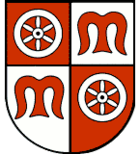| Dockings and Events |
|
| Museum Ship Vlotburg in Miltenberg starts on 13.07. till 15.08.2013 |
 |
Our location:

Miltenberg is the seat of the like-named district in the Regierungsbezirk of Lower Franco nia (Unterfranken) in Bavaria, Germany. nia (Unterfranken) in Bavaria, Germany.

Historic Miltenberg lies on the Main’s left bank on the “left knee” of the Mainviereck (“Main Square”) between the Spessart and Odenwald ranges. Since the Main riverbed in the Miltenberg area is relatively near the foot of the Odenwald, only a narrow strip of usable land is left, which in bygone centuries was time and again flooded by the Main. The Old Town, which stands on this land, sustained sometimes considerable damage in these floods. From about the beginning of the 20th century, after buying land from the neighbouring community of Großheubach, Miltenberg has been spreading itself out over on the right bank.
History
Historic Old Town and Mildenburg
Even as far back as prehistoric and early historical times, people knew about the strategic importance of the strait at the Main “knee” between the Odenwald and the Spessart, building mighty ringwalls on the Greinberg above Miltenberg and on the Bürgstadter Berg (mountains). About AD 155, the Romans laid down the almost dead straight “Forward Limes” on the Main. Near today’s Miltenberg, the Limes came up against the Main, which from here northwards formed the Roman Empire’s natural border with Germania. Remnants of two Roman castra can be found nearby, one between Miltenberg and Bürgstadt (Kastell Miltenberg-Ost) and the other between Miltenberg and Kleinheubach (Altstadtkastell).
Under the preotection of the castle of Mildenburg (built about 1200), the town of Miltenberg took hold. It had its first documentary mention in 1237. By about 1379, the two town towers, the Mainz Gate (Mainzer Tor) and the Würzburg Gate (Würzburger Tor) framed in the west and east today’s Old Town, which grew narrow and long between the river and the steep slope. Already by the Middle Ages, Miltenberg bunter was highly sought-after, with things such as grindstones and columns being hewn in the surrounding woods. Even before 1319, the Spital St. Peter (hospital) was founded by Archbishop Peter of Aspelt.
Inscription on the Heunen-Säule
Until 1803, Miltenberg belonged to Electoral Mainz. This is yet manifested in the town’s coat of arms, which bears the Wheel of Mainz as a charge. After the Reichsdeputationshauptschluss, Miltenberg passed to the Principality of Leiningen, with which it was incorporated into the Grand Duchy of Baden in 1806. After having become part of the Grand Duchy of Hesse-Darmstadt in 1810, the town finally became part of Bavaria in 1816.
From Miltenberg come the so-called Heunensäulen, some special sandstone columns meant for use more than a thousand years ago when Mainz Cathedral was being built. The master builder, however, decided that they were unneeded and they never became part of the cathedral. One of them now stands in Mainz’s cathedral square, a gift to the city on the occasion of the cathedral’s thousandth anniversary in 1975. It bears an explanatory plaque.
Miltenberg has an historical Old Town featuring many timber-frame houses. In 1912 and 1955, Miltenberg acquired lands over on the Main’s right bank to expand the town.
The castle has been under the town’s ownership since 1979. In 1971, the outside was renovated, beginning a years-long renovation and restoration project. In the castle’s inner ward stands the der Teutonenstein, a 5 m-tall sandstone column whose inscription’s meaning is to this day a puzzle.
In 2006 the town gained national fame through Auxiliary Bishop Ulrich Boom’s 20-minute-long bellringing performance during a National Democratic Party of Germany rally, which disrupted the extreme rightwing party’s proceedings.[2]

Quelle: wikipedia.org
|
|
 |
|
| |
|
|
|

